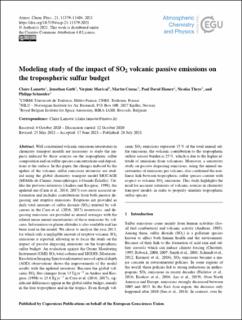| dc.description.abstract | Well constrained volcanic emissions inventories in chemistry transport models are necessary to study the impacts induced by these sources on the tropospheric sulfur composition and on sulfur species concentrations and depositions at the surface. In this paper, the changes induced by the update of the volcanic sulfur emissions inventory are studied using the global chemistry transport model MOCAGE (MOdèle de Chimie Atmosphérique à Grande Échelle). Unlike the previous inventory (Andres and Kasgnoc, 1998), the updated one (Carn et al., 2016, 2017) uses more accurate information and includes contributions from both passive degassing and eruptive emissions. Eruptions are provided as daily total amounts of sulfur dioxide (SO2) emitted by volcanoes in the Carn et al. (2016, 2017) inventories, and degassing emissions are provided as annual averages with the related mean annual uncertainties of those emissions by volcano. Information on plume altitudes is also available and has been used in the model. We chose to analyze the year 2013, for which only a negligible amount of eruptive volcanic SO2 emissions is reported, allowing us to focus the study on the impact of passive degassing emissions on the tropospheric sulfur budget. An evaluation against the Ozone Monitoring Instrument (OMI) SO2 total column and MODIS (Moderate-Resolution Imaging Spectroradiometer) aerosol optical depth (AOD) observations shows the improvements of the model results with the updated inventory. Because the global volcanic SO2 flux changes from 13 Tg yr−1 in Andres and Kasgnoc (1998) to 23.6 Tg yr−1 in Carn et al. (2016, 2017), significant differences appear in the global sulfur budget, mainly in the free troposphere and in the tropics. Even though volcanic SO2 emissions represent 15 % of the total annual sulfur emissions, the volcanic contribution to the tropospheric sulfate aerosol burden is 25 %, which is due to the higher altitude of emissions from volcanoes. Moreover, a sensitivity study on passive degassing emissions, using the annual uncertainties of emissions per volcano, also confirmed the nonlinear link between tropospheric sulfur species content with respect to volcanic SO2 emissions. This study highlights the need for accurate estimates of volcanic sources in chemistry transport models in order to properly simulate tropospheric sulfur species. | en_US |

